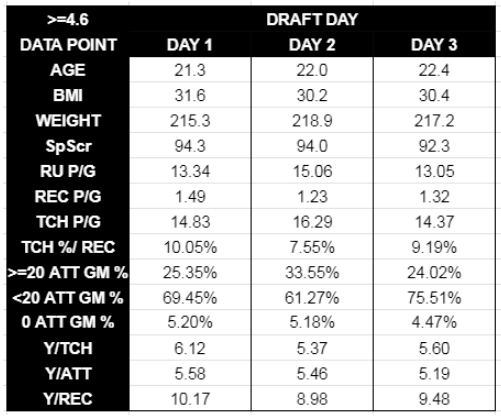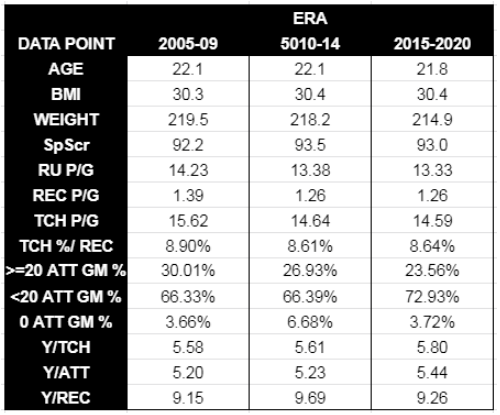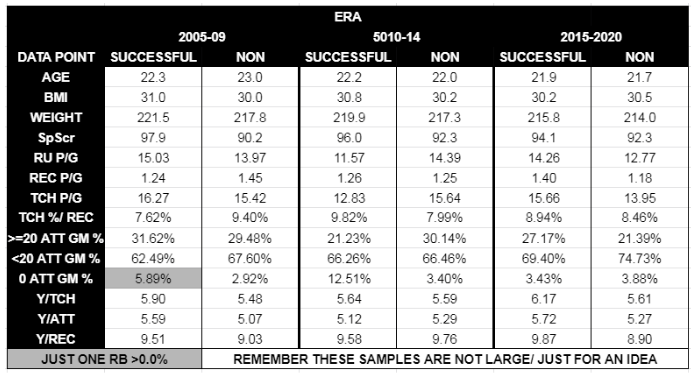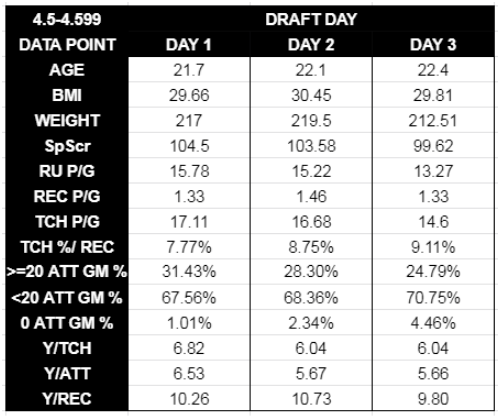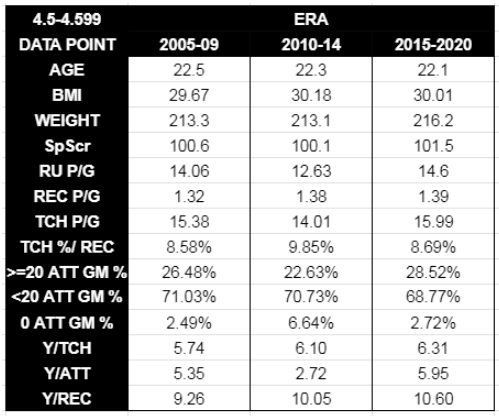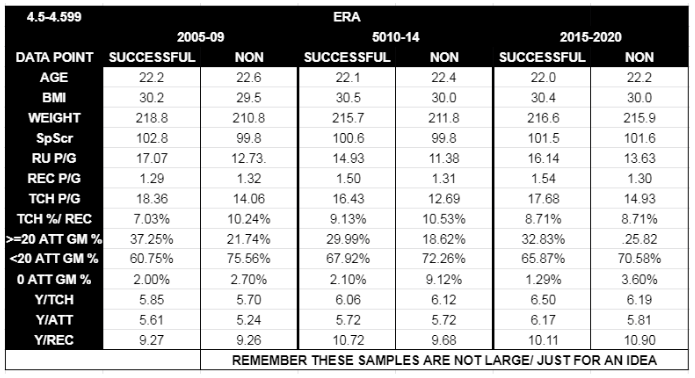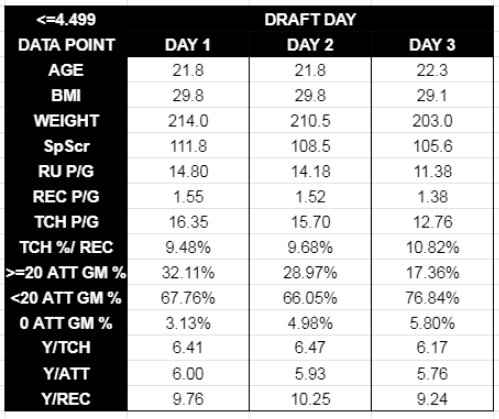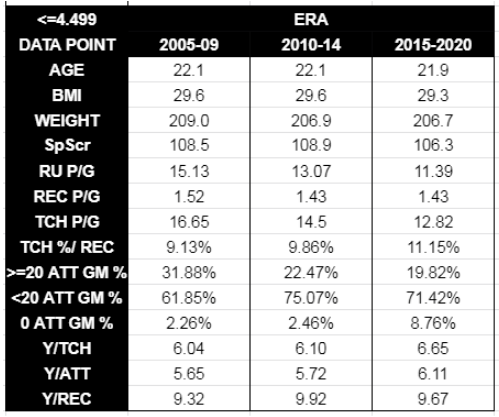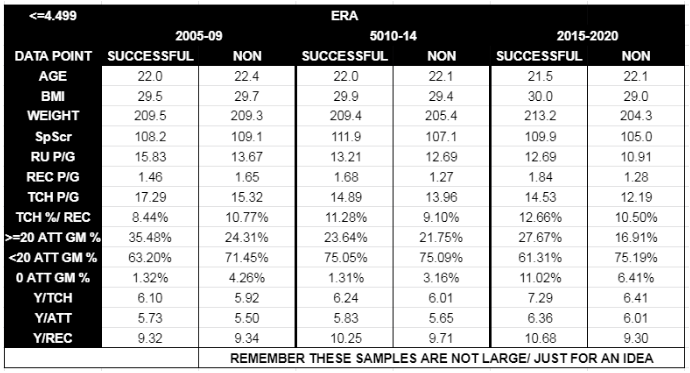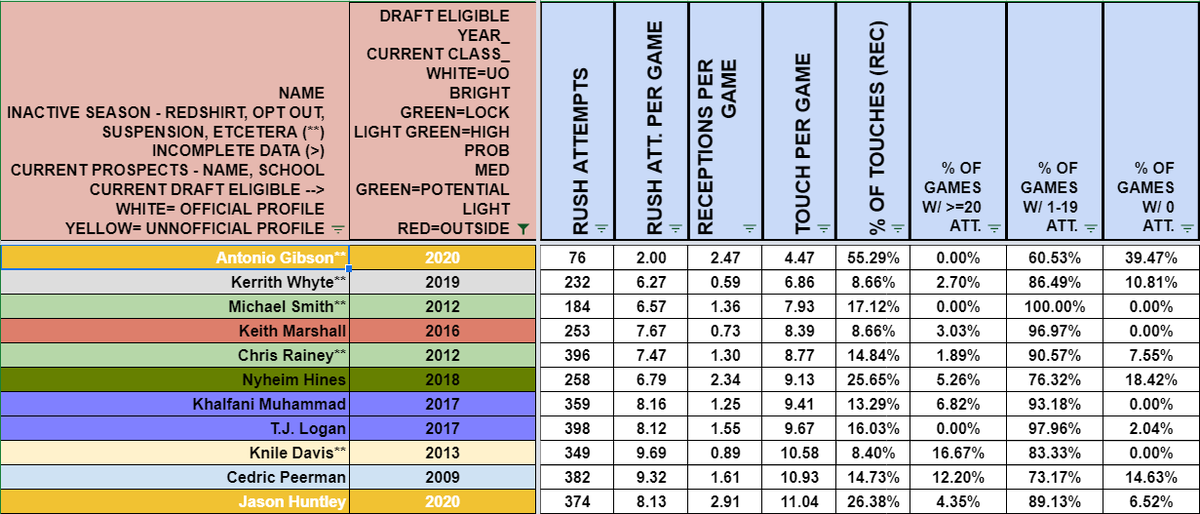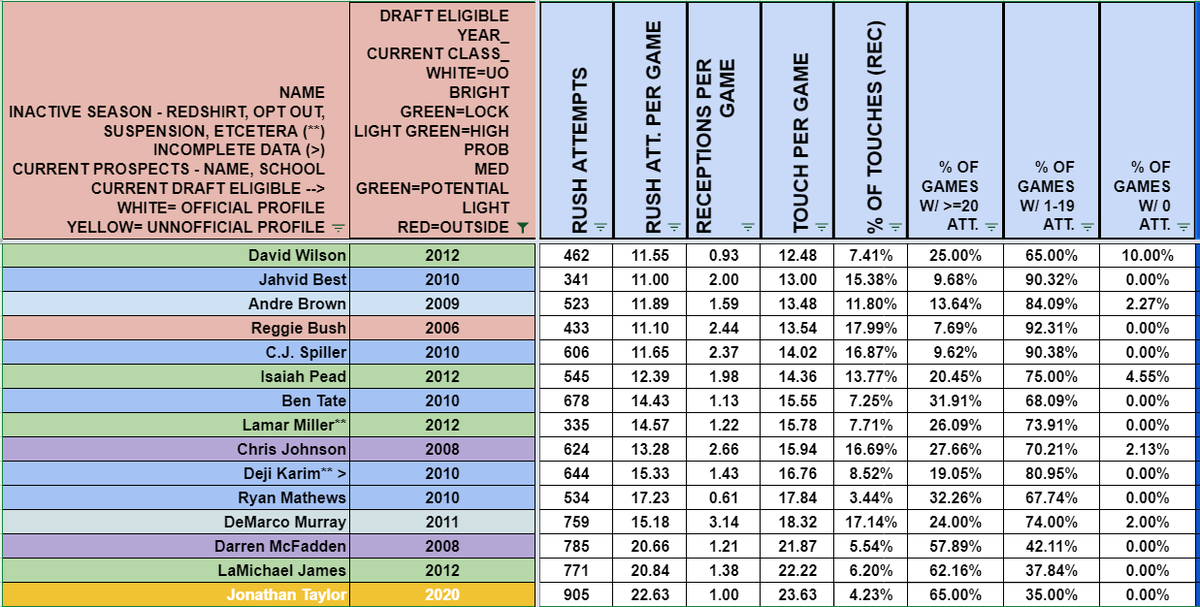Thread
How much does speed matter when it comes to being drafted vs succeeding in today& #39;s NFL at RB?
For this exercise, I have combined the 2020 class in the 2015-2019 sample as well as the RBs that ran <4.4 with the 4.4-4.499 based on much smaller samples.
Here we go...
How much does speed matter when it comes to being drafted vs succeeding in today& #39;s NFL at RB?
For this exercise, I have combined the 2020 class in the 2015-2019 sample as well as the RBs that ran <4.4 with the 4.4-4.499 based on much smaller samples.
Here we go...
73 RBs have been drafted since 2005 that ran >=4.6:
Rd1-4
Rd2-8
Rd3-13
Rd4-14
Rd5-4
Rd6-20
Rd7-10
PPR
24/73- >=150 pt 32.9%
10/73- >=225 pt 13.7%
3/73- >=300 pt 4.1%
Rd1-4
Rd2-8
Rd3-13
Rd4-14
Rd5-4
Rd6-20
Rd7-10
PPR
24/73- >=150 pt 32.9%
10/73- >=225 pt 13.7%
3/73- >=300 pt 4.1%
Drafted by era:
2005-09/ 24
Day1-1
Day2-6
Day3-17
PPR
Successful-6
Non-18
25%
2010-14/ 25
Day1-1
Day2-5
Day3-19
PPR
Successful-9
Non-16
36%
2015-20/ 24
Day1-2
Day2-10
Day3-12
PPR
Successful-9
Non-15
37.5%
2005-09/ 24
Day1-1
Day2-6
Day3-17
PPR
Successful-6
Non-18
25%
2010-14/ 25
Day1-1
Day2-5
Day3-19
PPR
Successful-9
Non-16
36%
2015-20/ 24
Day1-2
Day2-10
Day3-12
PPR
Successful-9
Non-15
37.5%
The amount drafted is nearly identical but 2020 is included. You can see above that prior to 2015, an RB running a 4.6 or slower 40 going on day 1 or two was a much rarer occurrence regardless. Prior to 2010, the success rate was about 12-13% lower.
2020
RD1-1
RD3-1
RD4-1
2020
RD1-1
RD3-1
RD4-1
Age is an easy one to follow throughout the process. Younger=better chance of being drafted/ better chance of being drafted early = better chance for success.
You can see though that size and athleticism have both narrowed when it comes to successful vs nonsuccessful RBs.
You can see though that size and athleticism have both narrowed when it comes to successful vs nonsuccessful RBs.
Volume has lessened and when we look through each era, we can see that being a successful RB early in the sample was more about being slightly more athletic with a less versatile skillset. Efficiency is always important but if you are slower, be able to catch it and be efficient.
I kept these general, it& #39;s a long enough thread as is.
Success by Competition
Power 5 (Every Year) - 17/55 (30.9%)
Non - 7/18 (38.8%)
>= 1 RB1 Season
Power 5 (Every Year) - 7/55 (12.7%)
Non - 4/18 (22.2%)
Possibly RBs overlooked by larger schools that shouldn& #39;t have been?
Success by Competition
Power 5 (Every Year) - 17/55 (30.9%)
Non - 7/18 (38.8%)
>= 1 RB1 Season
Power 5 (Every Year) - 7/55 (12.7%)
Non - 4/18 (22.2%)
Possibly RBs overlooked by larger schools that shouldn& #39;t have been?
122 RBs have been drafted since 2005 that ran 4.5-4.599:
Rd1-7
Rd2-17
Rd3-13
Rd4-21
Rd5-22
Rd6-19
Rd7-23
PPR
43/122- >=150 pt 35.2%
17/122- >=225 pt 13.9%
7/122- >=300 pt 5.7%
Rd1-7
Rd2-17
Rd3-13
Rd4-21
Rd5-22
Rd6-19
Rd7-23
PPR
43/122- >=150 pt 35.2%
17/122- >=225 pt 13.9%
7/122- >=300 pt 5.7%
Drafted by era:
2005-09/ 36
Day1-3
Day2-9
Day3-24
PPR
Successful-11
Non-25
2010-14/ 34
Day1-0
Day2-9
Day3-25
PPR
Successful-12
Non-22
2015-20/ 52
Day1-4
Day2-12
Day3-36
PPR
Successful-20
Non-32
2005-09/ 36
Day1-3
Day2-9
Day3-24
PPR
Successful-11
Non-25
2010-14/ 34
Day1-0
Day2-9
Day3-25
PPR
Successful-12
Non-22
2015-20/ 52
Day1-4
Day2-12
Day3-36
PPR
Successful-20
Non-32
Again, the weight and athleticism gap narrows.
Workload took a large dip from 2010-14 but has increased in recent years. The increase has been helped by an increase in receiving volume again. Successful and nonsuccessful RBs have identical rec % but volume is a decent gap.
Workload took a large dip from 2010-14 but has increased in recent years. The increase has been helped by an increase in receiving volume again. Successful and nonsuccessful RBs have identical rec % but volume is a decent gap.
You want volume and efficiency. In general, this is always a good rule of thumb. They don& #39;t handle it if they can& #39;t handle it.
The efficiency gap has widened slightly between successful and non but in general, as we will see, more efficient RBs being drafted period.
The efficiency gap has widened slightly between successful and non but in general, as we will see, more efficient RBs being drafted period.
We see again, playing at a lower comp is not a death nail but when it comes to high-end upside, it& #39;s starting to change.
Success by Competition
Power 5 (Every Year) - 25/76 (32.9%)
Non - 18/46 (39.1%)
>= 1 RB1 Season
Power 5 (Every Year) - 12/76 (15.8%)
Non - 7/46 (15.2%)
Success by Competition
Power 5 (Every Year) - 25/76 (32.9%)
Non - 18/46 (39.1%)
>= 1 RB1 Season
Power 5 (Every Year) - 12/76 (15.8%)
Non - 7/46 (15.2%)
116 RBs have been drafted since 2005 that ran 4.499 or faster:
Rd1-23
Rd2-18
Rd3-18
Rd4-22
Rd5-10
Rd6-11
Rd7-14
PPR
48/116- >=150 pt 41.8%
24/116- >=225 pt 20.7%
13/116- >=300 pt 11.2%
Rd1-23
Rd2-18
Rd3-18
Rd4-22
Rd5-10
Rd6-11
Rd7-14
PPR
48/116- >=150 pt 41.8%
24/116- >=225 pt 20.7%
13/116- >=300 pt 11.2%
Drafted by era:
2005-09/ 31
Day1-13
Day2-10
Day3-8
PPR
Successful-21
Non-10
67.7%
2010-14/ 37
Day1-6
Day2-13
Day3-18
PPR
Successful-14
Non-23
37.8%
2015-20/ 48
Day1-4
Day2-13
Day3-31
PPR
Successful-13
Non-35
27.1%
2005-09/ 31
Day1-13
Day2-10
Day3-8
PPR
Successful-21
Non-10
67.7%
2010-14/ 37
Day1-6
Day2-13
Day3-18
PPR
Successful-14
Non-23
37.8%
2015-20/ 48
Day1-4
Day2-13
Day3-31
PPR
Successful-13
Non-35
27.1%
Remember these are all RBs <=4.499.
We see that the weight and athleticism gap here has reversed course from the previous samples. As many of these backs are smaller the workload has lessened but versatility has the largest jump we have seen.
Remember these are just averages...
We see that the weight and athleticism gap here has reversed course from the previous samples. As many of these backs are smaller the workload has lessened but versatility has the largest jump we have seen.
Remember these are just averages...
...before ya tell me about Quon Zeke and JT. There are also guys like Michael Smith, Kieth Marshall, Chris Rainey, and Khalfani Muhammad.
Oh yeah and Antonio Gibson. The outlier of all outliers at RB.
Oh yeah and Antonio Gibson. The outlier of all outliers at RB.
Here is where the comp level starts to matter considerably more.
Success by Competition
Power 5 (Every Year) - 35/73 (47.9%)
Non - 13/45 (28.9%)
>= 1 RB1 Season
Power 5 (Every Year) - 18/73 (24.6%)
Non - 8/45 (17.8%)
Maybe the higher-level schools were right on these ones?
Success by Competition
Power 5 (Every Year) - 35/73 (47.9%)
Non - 13/45 (28.9%)
>= 1 RB1 Season
Power 5 (Every Year) - 18/73 (24.6%)
Non - 8/45 (17.8%)
Maybe the higher-level schools were right on these ones?
Again, these are averages based on 311 total drafted RBs since 2005. Some that haven& #39;t succeeded yet still have time. There are exceptions of course but this gives us a general idea. Don& #39;t avoid a sure thing because they don& #39;t exactly match the type. But if they are far below...
...avg in a few areas, it may be a reason to pause.
Takeaways:
1. Running fast has lessened in importance but it is still important. Being athletic at their size is with a diverse skillset is more important. If they don& #39;t catch it a lot, make sure they& #39;re efficient when they do
Takeaways:
1. Running fast has lessened in importance but it is still important. Being athletic at their size is with a diverse skillset is more important. If they don& #39;t catch it a lot, make sure they& #39;re efficient when they do
2. Don& #39;t ignore lower competition level RBs when they have shown to possess a three-down skillset and ability to handle a workload.
JRob is looking at you NFL...
JRob is looking at you NFL...
3. Running <4.4 does not guarantee success. Being able to handle a large workload, catch passes, and run <4.4 almost does. Having solid size helps a bit too.
Oh yeah, or be Antonio Gibson...
Oh yeah, or be Antonio Gibson...
4. The NFL has become better about finding efficient, versatile RBs. This makes picking the good from the bad tougher. Simply being big and fast is not everything anymore. The league will still draft AJ Dillon when he pops up and will still prob fade a 4.7+ like Arian Foster...
...but they are paying a bit less attention to pure speed. We should still love a 4.4 profile, but make sure the rest of the package is there. Don& #39;t fall head over heels for a 4.55+ that& #39;s shown to be good everywhere else, but don& #39;t ignore it either.
Thank you & hope this helps
Thank you & hope this helps
https://twitter.com/willson8tor/status/1374552182238814212?s=20">https://twitter.com/willson8t...

 Read on Twitter
Read on Twitter